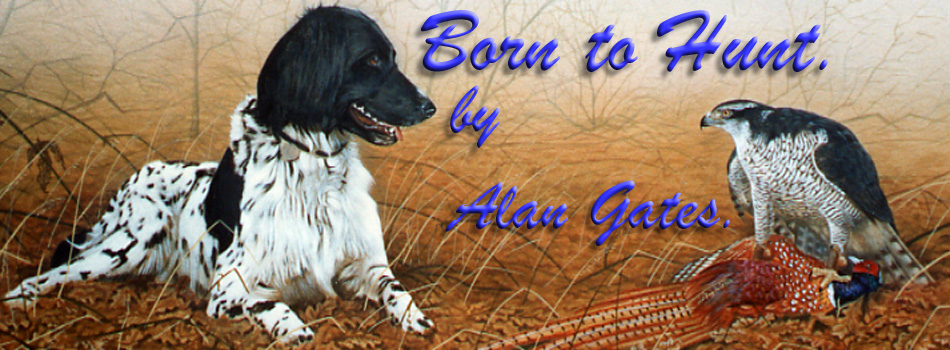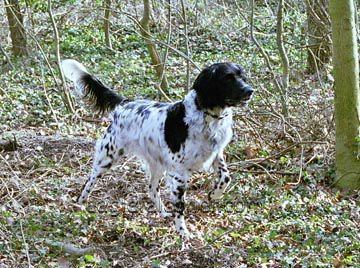 The woodland floor was covered with dead leaves which were crisp from a light frost and crunched under every footstep. Mine were slow and deliberate, but hers crackled and crashed as she rushed from one bramble patch to the next. Within a split second, silence fell as she froze in motion, her long plume of a tail feathered with a snow white flag arched skywards and quivered. The woodland floor was covered with dead leaves which were crisp from a light frost and crunched under every footstep. Mine were slow and deliberate, but hers crackled and crashed as she rushed from one bramble patch to the next. Within a split second, silence fell as she froze in motion, her long plume of a tail feathered with a snow white flag arched skywards and quivered.
As I slowly positioned myself alongside of her I could see her eyes were transfixed in the direction of her nose. There was no rolling of her eyeballs as she tried to look at me whilst her nose was locked as she did if the scent was cool. Full lockup was a pretty sure sign of a hot scent. I stood close to her and gentle touched her neck and shoulders, she was as hard as a bronze sculpture. I softly spoke words of encouragement as I surveyed the large growth of brambles in front of us.
The goshawk on my fist tensed her grip and tinkled a leg bell, the sound made her left ear flap quiver slightly and one front leg lifted just a touch.
I had no idea what game lay hidden in these brambles, rabbit or pheasant were the two most likely candidates. Unfortunately I had not managed to train her to point lifting a front leg for ground quarry or a back leg for winged.
I peered into the dense cover along the line of her nose but could not detect our quarry, this patch of brambles covered about thirty square metres. I gestured with my foot and gave the command “seek em out” and she burst into action.
To my surprise, instead of ploughing right into the cover she ran around the cover until directly opposite her point, and then ploughed in. This brought the quarry straight towards me, it exited to my right which was an ideal slip for the gos and the pitiful squeal confirmed a rabbit and its demise.
Success, in the fact that we had put game in the bag, but a far greater success, was that my Large Munsterlander “Siouxzee” was learning tactics through her own experience.
She had a number of surprises under her collar which manifested themselves at different times, her enthusiasm and pure love of hunting and working had transformed my experience, and revitalised my love of short-wing falconry.
I have been a ditch-kicking bush-bashing falconer since school days, and in those early days it was hard to tell between gos or falconer who was the keener or leaner.
I would traverse the countryside with the devastating effect of a hurricane, no likely looking cover would ever escape a thorough battering. Though as the years past I began to notice that certain deep bramble covered ditches or tall dense gorse patches were no longer being given the justice they demanded.
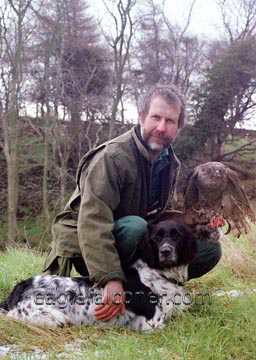 Goshawks and ditch-kicking faded as I concentrated my hunting time on hill flying “Maria” my female Golden Eagle. As the decades past she bonded and started to nest and lay eggs during the summer months. To help her gain parenting experience I gave her a succession of eyas buteo’s (Redtails and Common Buzzards) and once she had reared these I began to feel the urge to fly one of the Redtails around the farm. Goshawks and ditch-kicking faded as I concentrated my hunting time on hill flying “Maria” my female Golden Eagle. As the decades past she bonded and started to nest and lay eggs during the summer months. To help her gain parenting experience I gave her a succession of eyas buteo’s (Redtails and Common Buzzards) and once she had reared these I began to feel the urge to fly one of the Redtails around the farm.
This reawakening of a hedge-kicking type of falconry sparked within me the desire to obtain and train a good working dog. I had dabbled in the distant past with a couple of dogs for falconry but had never quite got it right. Either I had obtained the wrong breed of dog for falconry or the right dog but at the wrong time, both, I hasten to add, had lived a great life as family pets but at the same time had dampened my attitude towards owning a falconry dog, until now.
Somehow, this time circumstances felt different, perhaps I was at last mature and more settled in life. What ever the reason was, I dedicated the time and effort into research before I made any decisions.
Although the following may sound superficial or irrelevant, I actually feel it is paramount as a first step. “Choose a breed that you like the look of.” If you love your dog you will be more lenient as you both learn what is required of a falconry dog.
Then do the research to find out its suitability to your circumstances and find a breeder of the best working line of that breed.
I had always loved the look of working setters, spaniels or any long haired gun dog. The image of an elegant working setter on point with its fringes blowing in the breeze stirs something deep in my psyche.
What a load of tosh you might say, but with that fetish of an image lodged deep in the basement of my brain, I set about looking for a breed I had first met many years before.
In the last weeks of 1992 I took possession (or was it the other way round ?) of a bitch Large Munsterlander puppy. An old German breed once known as the Long Haired Setter, the Munsterlander is also known throughout the Germanic countries by falconers as the “Habicht hund” (Hawk dog). In the UK they are found within the HPR (Hunter, Pointer, Retriever) group and in the USA are known as one of the Versatile breeds.
Versatile they certainly are, as they are also valued for their blood tracking skills in finding wounded deer. For the falconer their aptitude as a hunter and pointer are the most important, but their love of retrieving is not to be discouraged as some may advocate.
“Siouxzee” as she was named wormed her way into my affection from day one. The breeders had nicknamed her “The Bandit”, but neglected to tell me this until after she had become my dog. Personality, intelligence and a natural working instinct was in abundance and we both spent the early years vying for control. Eventually we worked out a mutual respect for each other, and I ended up with a hunting partner that I had dreamed for, and she kept enough independence to surprise me with intelligent hunting manoeuvres of her own making.
Over the years she worked with a female Red Tail, a male Golden Eagle and two female Goshawks. It was with the Goshawks that her talents really shined. Maybe by then her experience with hawks had become second nature, but many times whilst hunting I felt little more than a spectator or mobile perch. Not that I am complaining, I just loved to watch both hawk and dog work a hedge or woodland undergrowth together.
Munsterlanders are not sissy dogs, well mine certainly was not. In fact her ‘macho’ attitude towards thorny cover could make a bulldozer wince. No cover no matter how thick ot thorny was ever refused, she would either jump or dig her way in and proceed to evacuate any creature using it as a refuge.
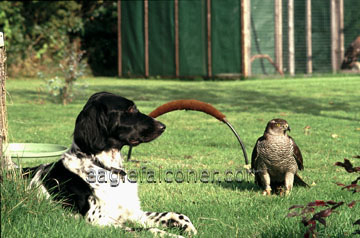 The moment a jangle of bells indicated a slip, a head would pop out of the cover to watch the action. If unsuccessful then she would continue to rag the undergrowth but if the hawk bagged the quarry she would come to lay by my side as I dispatched the quarry and picked up the hawk. Her motive here was to get her reward alongside of the hawk as an important part of the team. The moment a jangle of bells indicated a slip, a head would pop out of the cover to watch the action. If unsuccessful then she would continue to rag the undergrowth but if the hawk bagged the quarry she would come to lay by my side as I dispatched the quarry and picked up the hawk. Her motive here was to get her reward alongside of the hawk as an important part of the team.
Her antics and her enthusiasm gladdened my heart and added an enormous extra enjoyment to my ditch and bush hawking. When faced with many areas of cover, at times she would miss what I thought looked like ideal cover that would yield game. Calling her back to me I would insist she investigate this honeypot. For this I would receive a look of disbelief and then one of disdain before she dived in to make a huge show of cover destruction which confirmed not even a mouse was at home. Having humoured me she would return to the serious job of game detection.
She grew up with water around her as we have a couple of small rivers or beck's as they are called in Yorkshire on our farmland. At three months old she was swimming in the shallow water and soon became as proficient as an otter.
One cold winter afternoon we were hawking the farm wood when we flushed a hen pheasant. It rocketed skywards to clear the tree line with my Finn female gos in hot pursuit. “Siouxzee” and I stood transfixed to the spot both looking towards the sky at the point where we had lost them from view.
I leapt forward and ran towards the top end of the wood where the beck cut a barrier from the fields. When I cleared the trees with “Siouxzee” at my side there was no sign of the gos. I was hoping for some corvid commotion or at the least an agitated blue tit. Silence, I looked around not really knowing which direction they had gone and aimlessly ran along the river bank.
When I was out in the open I felt a few swings of the lure might get a bell to move at least. Instead I 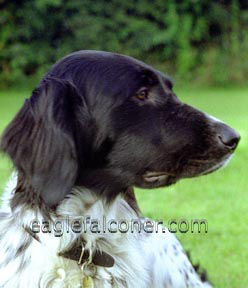 heard what I thought was a cross between a cough and a gurgle. “Siouxzee” was about fifteen metres behind me and the sound seemed closer to her than me. She had heard it also and slipped down the river bank and into the water, that's when I saw the gos laid spread-eagle in the middle of the slow moving river. heard what I thought was a cross between a cough and a gurgle. “Siouxzee” was about fifteen metres behind me and the sound seemed closer to her than me. She had heard it also and slipped down the river bank and into the water, that's when I saw the gos laid spread-eagle in the middle of the slow moving river.
“Siouxzee” was swimming up river towards the gos and I thought she intended to retrieve the gos, but instead she tentatively pushed the gos towards the bank. In fact her first gentle shove was enough for the gos to awaken from her trance and start to wing-flap swim to the bank where I scooped her up to find the hen pheasant grasped in both feet.
Training a working dog to become a valuable partner to the hawk in the field can take a huge commitment. I am not sure if the comparison is valid because I have trained hawks since school days, but I found my venture with training a hunting dog a lot more intense and rewarding.
I found her love and bred-in instinct for retrieving to be a great asset as a means of extra exercise and way to encourage communication between handler and dog.
Memory retrievers taught her control with added exercise, multiply retrieves taught her to look to me for assistance if the scent is poor. I found this is really a valuable way to train to hand signals, as well as voice and whistle, it takes time and commitment, but when you are able to use a combination of commands things really begin to gel when the action starts in the field.
She became my shadow, ever loyal, full of fun with an irresistible personality but above all in her heart she was a working dog first and foremost.
I write this with a lump in my throat and a heavy heart for it is nearly thirteen years since the “Bandit” came into my life. The ravages of time have recently taken her from me but her personality and her love of hunting with hawks will always live in my memory. Together we took hedge and ditch hawking to much higher level of enjoyment. “Thank you sweet Siouxzee”.
|
